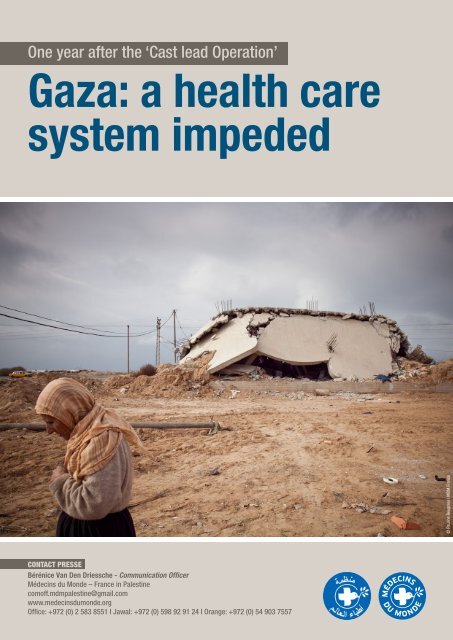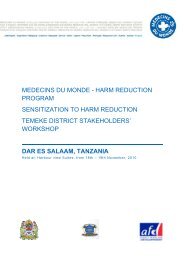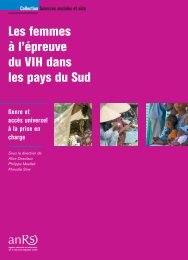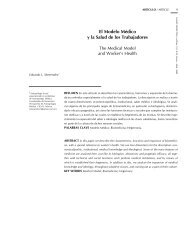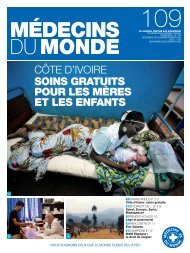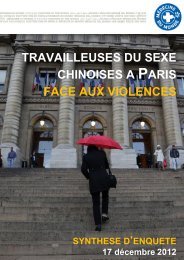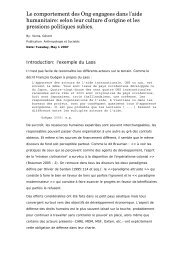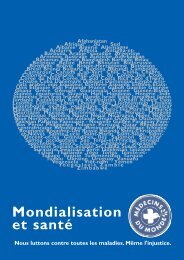Gaza: a health care system impeded - Médecins du Monde
Gaza: a health care system impeded - Médecins du Monde
Gaza: a health care system impeded - Médecins du Monde
- No tags were found...
You also want an ePaper? Increase the reach of your titles
YUMPU automatically turns print PDFs into web optimized ePapers that Google loves.
One year after the ‘Cast lead Operation’<strong>Gaza</strong>: a <strong>health</strong> <strong>care</strong><strong>system</strong> <strong>impeded</strong>© Pauline Beugnies I MDM FranceCONTACT PRESSEBérénice Van Den Driessche - Communication OfficerMédecins <strong>du</strong> <strong>Monde</strong> – France in Palestinecomoff.mdmpalestine@gmail.comwww.medecins<strong>du</strong>monde.orgOffice: +972 (0) 2 583 8551 I Jawal: +972 (0) 598 92 91 24 I Orange: +972 (0) 54 903 7557
A doctor’s tale from the eye of the stormI remember that Saturday like it was yesterday, and I guess I will never forget it. The first attack started around 11.20 AM: around thetime of the prayers, when the schools ended and when the children crowd the streets of <strong>Gaza</strong>. I was in a training with MDM-F whenwe heard the first bombing. One time, two times,… six… ten…. And all along we heard the noise of the warplanes… From our tallbuilding, we could see dozens of columns of dark, black smoke. And every minute, a new column appeared. For the first 30 minutes,we thought they were isolated attacks, but later that day, when it did not stop, we understood it was the war.Our mobiles were off, no one had network and we could not connect with our relatives nor with our base in Jerusalem. I took theresponsibility of sending the trainees home. Each one of us needed to feel safe, with our families and children.I reached my house in Khan Younis after a big traffic delay since the roads were congested <strong>du</strong>e to the panic. But I reached it safely thoughbombs were hitting more frequently. I joined my wife and my four children, they were frightened. Few minutes later, the Red Crescenthospital of Khan Younis called me: Every doctor of <strong>Gaza</strong> was called in. My wife was terrified; she did not want me to leave. “You have justarrived with us”, she begged. But I had to go.24-long hours of unrest followed. Casualties, wounded and burnt victims were rapidly coming in and started flocking the hospital.Electricity and water were often cut, sometimes for 3 days in a row. Hospital devices were relying on generators. I saw the family of somepatients in need of an artificial respirator, pumping manually to provide air to the wounded, until electricity would come back.Intensive Care Units (ICU) and ER rooms of the main hospitals were overcrowded… Maternities were converted into ICU and chronicpatients sometimes sent home to make space for urgent cases.Every three days, I had to take a 24 hour shift at the hospital. The two other days, I simply stayed at home, confined with my family,tirelessly watching the tragic news on TV… On the third day, 5 members of my family were killed, including a 7 year-old boy. And it wenton at this rhythm until the end of the war: hearing airplanes, drones and missiles, recognizing their specific sounds, ensuring the children’s‘safety’ away from doors and windows, sleeping s<strong>care</strong>d… Listening to the unfolding tragic news, hearing about the losses within families,visiting and treating the countless wounded, the widows, mourning, grieving, and treating the wounded at the hospital…After a couple of days, humanitarian assistance arrived in the Strip. There were many donations: drugs, equipment, ambulances. But itdid not solve everything. Drugs were near their expiry date and generally had a short shelve life. Materials were useful but often old orrequiring spare parts that were impossible to purchase in <strong>Gaza</strong>. As for ambulances, 15 new vehicles were not very useful, when - becauseof the closure- fuel became scarce.Dr. Ahmed Abu Teir is a surgeon from <strong>Gaza</strong>.He has been working with MDM-F since 2002where he is currently the medical base manager© Pauline Beugnies I MDM France<strong>Gaza</strong> city, one year after the « Cast lead » operation. The Abed Rabbo neighborhood has been badly destroyed <strong>du</strong>ring the military operation.Today, the material needed to rebuild homes and infrastructures is cruelly missing.
GAZA: A CONTEXT JEOPARDIZING THE DEVELOPMENT OF THE HEALTH CARE SYSTEMAt the time of commemorating the one-year anniversary of operation “Cast Lead”, the situation for 1.5 million Palestinians in the <strong>Gaza</strong>Strip is getting increasingly worse. Yet, the latest Israeli attack must be viewed in the wider context of the increasing isolation andimpoverishment of the <strong>Gaza</strong> Strip.The high demographics of the <strong>Gaza</strong> population- the most densely populated area in the world-inevitably causes a lot of pressure to beexerted on the <strong>health</strong> sector. It must respond not only to the current contextual challenges resulting of the blockade and the previous war,but also to the increasing demands for <strong>health</strong> services resulting from a rapidly increasing population.SOCIO-ECONOMIC PROFILE OFTHE GAZA STRIPTotal population1.416.539 people (including 69% of refugees)Population density4.500 inhabitants per km2(France: 93,59 hab./km2)One year after the end of the offensive, many of the primary <strong>health</strong> <strong>care</strong>improvements that have been previously achieved are now at risk. Socioeconomicaldeterminants and environmental factors, compounded by the currentemergency situation have increased the demand for <strong>health</strong> services, which donot meet current domestic resources capacities or substantial internationalresources.Fertility rate6 (Egypt: 3.5)Life expectancy73 yearsAverage family size6.5Age structureAround 45.5% of the populationis under age 15Unemployment rate65%Dependence ratio1:8.5(one working person sponsors 8.5 persons)The Al Atatra clinic where MDM-F works has been destroyed <strong>du</strong>ring last year’s attacks. Sincethen, MDM-F has been renting a house nearby, until it the initial centre will be rehabilitated.Today, few families whose houses have been destroyed still live in tentsin front of the medical centre.© Pauline Beugnies I MDM FranceThe impact of the Israeli blockade on <strong>Gaza</strong>© Pauline Beugnies I MDM FranceThe water sewage <strong>system</strong> has been badly impacted by theWar. Today, the sewage is being discharged into the sea.The ongoing two year-and-a-half Israeli blockade on <strong>Gaza</strong> has negativelyimpacted the human rights of the citizens in the <strong>Gaza</strong> Strip, including the right to<strong>health</strong>. Since then, <strong>health</strong><strong>care</strong> for people in <strong>Gaza</strong> has dramatically deteriorated attwo levels: the provision of <strong>health</strong> services inside <strong>Gaza</strong> and access to treatmentoutside <strong>Gaza</strong>.As a direct result of the blockade, <strong>Gaza</strong>’s economy has all but collapsed,unemployment and poverty have sky-rocketed and essential public infrastructuresuch as <strong>health</strong>, water and sanitation networks have deteriorated at an alarmingrate, while basic foodstuffs, fuel and medical supplies have been in short supply.Since June 2007, Israel has been imposing restrictions on the movement ofgoods and people at <strong>Gaza</strong>’s border crossings. People, including those in needof medical attention, have not been able to get out, while most of raw materialsneeded for rehabilitating and re-building <strong>health</strong> facilities are denied to enter theterritory.
GAZA’S HEALTH SECTOR IN 2009Compared to other countries at a similar level of economic development, the Palestinian population’s overall <strong>health</strong> status outcomes arerelatively good. They are noticeably better than the neighboring Arab states (Jordan, Egypt, and Syria) and reflect strong performances onmost basic public <strong>health</strong> and primary <strong>health</strong> <strong>care</strong> functions.The strengths of the Palestinian <strong>health</strong> <strong>system</strong> includes a relatively <strong>health</strong>y population, a high societal value placed on <strong>health</strong>, qualifiedand experienced <strong>health</strong> professionals and national plans for <strong>health</strong> <strong>system</strong> development. Still, in <strong>Gaza</strong>, human resources in the <strong>health</strong>sector are below regional standards and the achievements that have been made over the past three decades are now being dramaticallyeroded, placing the <strong>Gaza</strong> strip in a state of almost chronic emergency over the last three years.IN 2009, HEALTHCARE SERVICES IN THE GAZA STRIP HAVE BEEN FACING THE FOLLOWING CHALLENGES: (i.e specialized <strong>health</strong> <strong>care</strong> requiring surgical proce<strong>du</strong>res, technological resourcesand multiple specialists and subspecialists) inside and outside the <strong>Gaza</strong> Strip remains extremely limited<strong>du</strong>e to the blockade further impacting the lack of (new) surgical expertiseA Primary Health Care sector highly used but largely neglectedIn <strong>Gaza</strong>, the Ministry of Health (MoH) has established a large network of 56 primary <strong>health</strong> <strong>care</strong> centers geographically spread throughoutthe <strong>Gaza</strong> Strip. Those centers provide general <strong>health</strong> <strong>care</strong> services to a large part of the <strong>Gaza</strong>’s population, providing preventive, promotionaland rehabilitative treatment for a<strong>du</strong>lts, children and babies.A continuous lack of resources (manpower, equipments, drugs and training)…Nevertheless, despite a reasonably extensive coverage network, PHCCs are suffering from a lack of resources at all levels: no reliablesupply of essential drugs (no buffer stock), medical equipments, materials, instruments, consumables, and manpower.Europe the ratio reaches respectively 579 and 713.… Despite a high using level of Primary Health Care servicesperceived bad living conditions, unemployment, poorly rated <strong>health</strong> status and smoking habits.According to a MDM-F pilot study carried out within 6 PHCC’s across the <strong>Gaza</strong> Strip (November 2009) 1 : 21% between 16-31 years old21% over 51 years old19% between 0 to 5 years-old 1The pilot study was carried in the PHCC’s of Jabalia Martyrs (North area), Zeitoun (<strong>Gaza</strong> city), Sabha (<strong>Gaza</strong> city), Deir Balah (Middle area), Khan Younes (South area) and Rafah (South area) on 343 patients.
MDM-F’S RESPONSE:Strengthening the emergency response capacities and the management of emergency cases by supportingemergency rooms of 11 primary <strong>health</strong> <strong>care</strong> centres (PHCC), through providing specific items, medicine andessential medical equipments and providing training (practical and theoretical) adapted to <strong>Gaza</strong>’s complex andchronic humanitarian crisis context.- 90.000 emergency <strong>care</strong> consultations have been con<strong>du</strong>cted in the 11 MoH Primary Health CareCenters equipped by Emergency Room and supported by MDM-F <strong>du</strong>ring 2009- 44 emergency staff (22 doctors and 22 nurses) from PHCC-ERs have benefited from theoretical,practical and in-service emergency medical <strong>care</strong> trainingDeveloping a referral <strong>system</strong> between PHCC’s providing emergency services and hospitals.which has been the cause of her sufferingImpeding the surgery sectorSince the blockade imposed on the <strong>Gaza</strong> Strip, hospitals in <strong>Gaza</strong> continue to lackvital medical equipment along with a shortage of medicines (including anesthetics)and medical supplies, as well as trained personnel to carry out advanced medicaltreatment, including many surgical operations, such as cardiovascular surgery,orthopedic and neurosurgery. As a matter of fact, in addition to a serious lackof resources, Palestinian surgeons are mainly facing a lack of knowledge andexperience regarding certain specialties in the surgery sector.© Pauline Beugnies I MDM FranceShada’s father recollects: ‘’<strong>du</strong>ring the war wewould all stay indoors. One day I had to takeShada to the hospital for her physiotherapysession. Yet, ever since the siege on <strong>Gaza</strong> therehas been a shortage in fuel, which got worse<strong>du</strong>ring the war. I was unable to drive to thehospital, we were also afraid of being attackedon the way…’’.When Shada’s parents first discovered herdeformity, they took her to a number ofspecialists in <strong>Gaza</strong>, who unanimously gavethe same verdict: ‘’you need to seek treatmentfor your daughter outside of <strong>Gaza</strong>, we cannotperform spinal surgery here’’. Her fathercontinues: ‘’financially, we cannot afford totravel abroad; I have eight children to support,with very little means. The operation costsaround $15, 000 and even if I did have themoney, we will not get permission to travel’’.In 2007, Professor Sylvain Terver (FR), a specialist in orthopedic <strong>care</strong>, con<strong>du</strong>ctedan assessment of the orthopedic services within the main hospitals of the <strong>Gaza</strong>Strip: Shifa medical compound, Nasser, Al Aqsa and the European Hospital inKhan Yunes. The assessment confirmed an important lack of medical equipmentneeded for orthopedic surgery, a lack of maintenance of instruments (spare partsnot available) and a shortage in adequate professionals, especially in orthopedicspinal surgery, and pediatric orthopedic.No doubt that following operation ‘Cast Lead’ of last winter, the number of patientssuffering from ortho-trauma has risen. However, with 45% of the population underage 15, and considering some socio-cultural determinants, ortho-malformationsaffecting young children appear as a crucial social and economical concernfor the <strong>Gaza</strong>n society as it might increase the number of disable people in thecoming years.A Lack of Resources (operating theatres, medical equipments, implantsand instruments)…The overall number of operating theatres per hospital is quite limited regardingthe increase of needs. As well, many of the instruments and trauma implants aremissing or are now out-dated in most of the hospitals in the <strong>Gaza</strong> Strip. Whilemany of the anaesthetic machines and monitors are not compatible (mainlyregarding pediatric surgery), some machines appear out-dated in most Hospitalsvisited.… And an insufficient ManpowerThe recommended ratio of orthopedic consultants per capita is 1 per 20,000 (EUrespective teams of junior doctors and Trainees, would be needed to cover the<strong>Gaza</strong>’s 1.5 million people.
MDM-F’S RESPONSE:einforcing the general <strong>health</strong> sectorin <strong>Gaza</strong> by supporting the MoH in fillingthe gaps in the tertiary <strong>health</strong> <strong>care</strong>service and priority sectors such asorthopaedic surgery (9% of the total ofreferral cases).Facts and Figures on medical referrals abroad(2007-2008).in the MoH’s budget since 2005, seriously limiting the Ministry’scapacity to further develop the <strong>health</strong> services.referral outside <strong>Gaza</strong>, accounting for 16% of the total number ofpatients seeking treatment abroad.10% in 2006 to 44% in 2008.<strong>Gaza</strong>.The Invisible wounds: Mental <strong>health</strong> impact on childrenAt the mental <strong>health</strong> level, operation ‘Cast Lead’ exposed children to high levels of stress, as the timing of the attack coincided with themid-day change in school shifts when the majority of <strong>Gaza</strong>’s schoolchildren were either in school or in proximity to their schools. Childrenwitnessed horrific scenes of violence and were deprived of their own protective environments such as their homes and schools. As reportedas troubled sleep, depression and anxiety, social difficulties, higher rates of delusional, obsessive and scary thoughts, delinquency andviolent behavior. These psychological symptoms have persisted, and are still present one year after the end of the offensive.In the street of the Samouni family that has become sadlyfamous since the loss of 21 of its members<strong>du</strong>ring last year « Cast lead » operation.Those boys lost both of their parents© Pauline Beugnies I MDM FranceMEDICOS DEL MUNDO-SPAIN’S RESPONSE:Supporting <strong>health</strong> professionals in Nasser, Kamal A<strong>du</strong>an and Shifa hospitals. Likewise, also the CrisisIntervention Team and the Trauma Center in their fieldwork in the most affected areas.Providing technical support to Jabalia and Sourani Community Mental Health Centers working with the teamsto improve the quality of services for the people who are still suffering from the traumatic events as well as forothers who come with different kinds of mental disorders.


